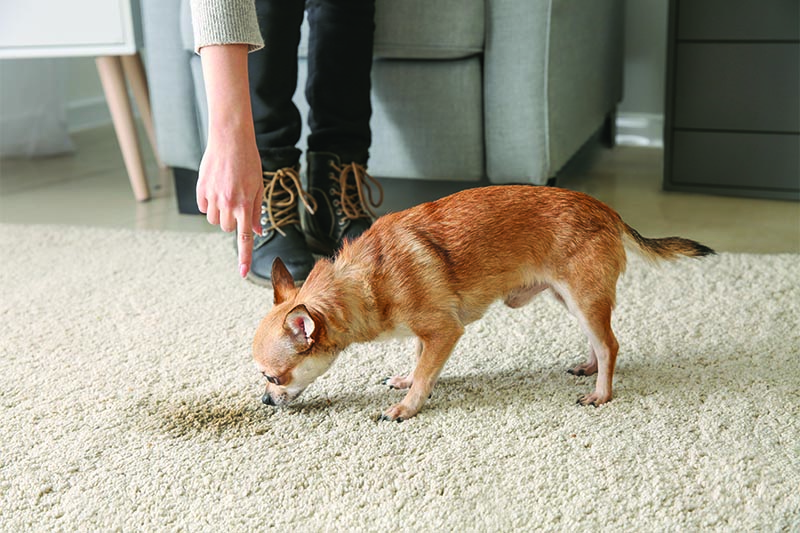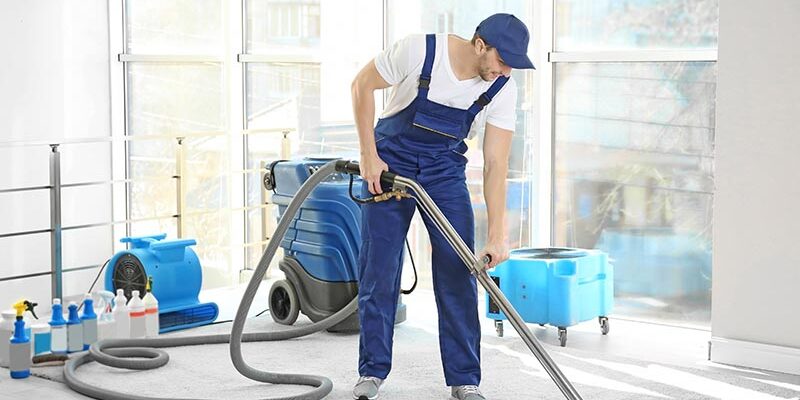Oxidizers Win the Urine Odor Battle, Not the War

By Brandon Branco
It seems the world has gone oxi-crazy since the OxiClean infomercials of the early 2000s. We use hydrogen peroxide in the cleaning and restoration industry to brighten, sanitize, and eliminate stains, but just how effective are oxidizers at eliminating pet urine odors?
While they work instantly on urine odors, oxidizers are actually counterproductive at delivering long-term, odor-eliminating results. Oxidizers remove the appearance of organic stains while having antimicrobial effects. While they quickly eliminate urine odors, many professional cleaners may not fully understand what is occurring and why they are providing a short-term solution to a long-term problem.
One of the greatest misconceptions in our industry is that oxidizers eliminate pet urine odors permanently, but the nitrogen cycle teaches us otherwise.
Understanding the nitrogen cycle in relation to oxidizers and urine
Our ecosystem has an interesting way of renewing life-giving nutrients, and nitrogen is one of the most abundant. All forms of life require nitrogen as it is one of the building blocks of our existence. Nitrogen helps create amino acids that ultimately result in DNA, which is critical for life and reproduction.
The nitrogen cycle reflects how nitrogen converts from solid, liquid, and gaseous forms as it cycles through our environment. Lightening, rain, decaying waste, and microbes all play an important role in the nitrogen cycle, and pet urine within carpet is no exception.
When it comes to applying oxidizers to pet urine contamination, the results are instant. The odor disappears immediately but for reasons that are counterproductive. Pet urine contains many sources of nitrogen including creatinine, urea, and uric acid (uric salt). Special ammonifying bacteria populate the nitrogen-rich waste to break down the nitrogen into its gaseous form of ammonia. This stage within the nitrogen cycle is known as ammonification. The resulting ammonia gas is lighter than air and becomes an unpleasant nuisance within a home as it wafts upward.
Ammonifying bacteria
Oxidizers eliminate bacteria on contact, particularly the ammonifying bacteria that were there converting the nitrogen to ammonia. While the urine odor may be gone, eliminating the bacteria is winning the battle, but losing the war. Because oxidizers and other non-bacterial cleaners cannot remove nitrogen, the area will eventually repopulate with ammonifying bacteria until the nitrogen is successfully converted to ammonia—no exceptions. Oddly enough the ammonifying bacteria were helping rid the area of nitrogen, just not fast enough for the customer’s sense of smell.
Uric salt
Another concern with using oxidizers is that they do not effectively remove the uric salt. Uric salt, a waste product of pet urine, is a desiccant that absorbs moisture while providing life-giving water for bacterial growth. Once the hydrogen peroxide loses oxygen, it turns into water.
The sodium and nitrogen content of uric salt, along with atmospheric moisture, creates the perfect environment for the ammonifying bacteria to return. I call this the “uric salt cycle” as it kickstarts the nitrogen cycle within a habitable environment, which produces ammonia gas on days of high humidity. The moist uric salt now has all it needs to welcome the bacteria back.
Permanent pet urine odor removal
Is complete urine odor removal even achievable? The only way to remove urine odor permanently is to replace the carpet and pad and either seal or replace the sub-floor beneath. But this is unnecessary as there are products available that can eliminate significant amounts of urine odor by using the nitrogen cycle to its advantage.
Aside from replacing the floor, the only effective way to eliminate the nitrogen is to speed up the ammonification process by adding more bacteria—not taking them away with oxidizers. A quality spore-form bacterial digestant creates enzymes to help the ammonifying bacteria to digest the available nitrogen. This allows the nitrogen to quickly pass to its gaseous form of ammonia.
Changing cleaner and customer expectations
As previously stated, enzymes offer a more permanent solution for pet urine odor removal. Next to completely replacing the floor, no cleaning solution can offer complete pet urine odor removal. While complete odor removal may occur, it is a low possibility. Pet urine can seep deep into fibers, wood, and concrete subfloors, and one or two service visits just cannot reach all the contaminated areas.
Because oxidizers work so fast at eliminating urine odor, the industry as a whole has grown more confident in offering urine odor removal cleaners. However, as long as the nitrogen remains, the nitrogen cycle will continue, and the ammonia smell will return. Even if we professional cleaners offer a quality, spore-form bacterial digestant that is applied perfectly, we should still approach pet urine with far more humility and with mitigation in mind. We should not only be focusing on mitigating the odor significantly, but also educating our customers on why full odor removal is unlikely. While complete odor removal may occur, pet urine that has permeated hardwood or concrete subflooring is far more troublesome long term than most may realize.
No new floor, no odor guarantee
We need to inform our customers that the only way to achieve complete urine odor removal is to replace the carpet, pad, and subfloor. This is the key to delivering realistic expectations and ensuring we are not fully liable if odors remain.
While some customers may consider replacing the floor, it is best to inform them that treating the odor first justifies the cost even if it is a failure. Treating pet urine is only 5% of the replacement cost of new carpet and pad, so odor treatment is well worth the attempt. When a customer understands that replacing the floor is the only way to eliminate the urine odor, it recasts our role as a professional mitigator rather than an odor eliminator.
By no means does this mean we are attempting to flee liability, but there are a handful of solid reasons to never guarantee complete urine odor removal. I have experienced countless conversations in which I had to remind customers of our disclaimer that complete floor replacement is the only way to meet their expectations if they want a 100% urine odor removal guarantee.
The oxidized battle cry
I have heard many professional cleaners say they do not have time for enzymes to work and have oxidized urine jobs for years without any callbacks. This repeated expression is a near battle cry within industry forums, likely because oxidizers deliver such instant results. However, after the oxidizing effect dissipates, the nitrogen cycle continues, as do odors and the potential loss of reoccurring business.
It is important to realize that our customers are the opposite of us cleaners. We are typically the DIY type; they are not. When the odor returns, many will call on your competitor without you knowing. I know this firsthand because it is exactly how I gained many customers when I started my cleaning business years ago.
Most of our customers are loyal to results and value only. They have to be since they can’t simply do it themselves. Unfortunately, gauging results by lack of callbacks is not a successful strategy to measure results or success; rather, try calling those customers a month or two after the service.
Rethinking our role
Pet urine is so pervasive that it may require additional applications on separate appointments. Yes, one service visit may not cut it. The cleaning company cannot be faulted for this if they fully disclaim the nitrogen cycle and use a quality enzymatic cleaner properly. There are several reasons we cleaners should not take fault, and the big one is that pet urine can seep deep into textiles, hardwood floors, and concrete where one service visit is just not enough. It does become the cleaning company’s fault when they do not educate the customer on the nitrogen cycle and the possibility that complete odor removal may not occur.
Becoming the expert by educating the customer on the nitrogen cycle is a way to grow the credibility of your brand in the long run. Explaining the nitrogen cycle sets realistic expectations, gains trust in your brand, and gives you more credibility as an expert even if some odor remains. Oddly enough, assuming the role of mitigating the urine odor instead of guaranteeing complete odor removal produces better customer satisfaction, more referrals, and a trustworthy reputation.
Brandon Branco is the owner and head formulator of Ur-OUT Brand Products headquartered in the Chicago area. He is the previous owner of a water damage restoration company in Indiana and the current owner of a floor cleaning company in Nashville, Tenn. Visit uroutodor.com for more information.












